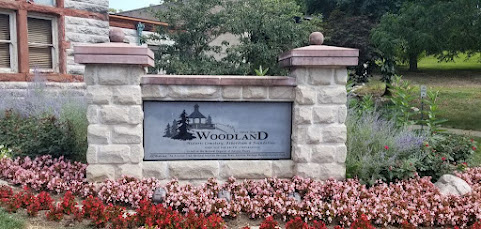While we were at Carillon Park, we realized they provided tours of Hawthorn Hill, the home to the Wright Family. Although both Orville and Wilbur were involved in planning the home, Wilbur died of typhoid fever on May 30, 1912, at age 45. Upon completion in 1914, Hawthorn Hill became the residence of Orville, his sister Katharine, and their elderly father, Bishop Milton Wright. We were happy there was availability so we hopped on the tour bus and rode the short distance to the home.
For 34 years, this house was the gathering place for some greats in American history - Charles Lindbergh, Henry Ford, Thomas Edison, President Franklin Roosevelt, Alexander Graham Bell to name a few. After Orville's death, the home was owned by the NCR Corporation and it was used as a guest house for corporate VIPs and for corporate functions. On August 18, 2006, the company donated the historic home to the Wright Family Foundation in honor of Orville's 135th birthday and National Aviation Day. A few years later, the Foundation asked Dayton History to manage and interpret the home.
Our guide, Tim, had a lot of stories to tell us about the house.
The front hall.
Only Orville's study approximates its pre-1948 appearance.
The electricity for the desk lamp was one of Orville's inventions. Notice that the cord comes from the overhead fixture to bring electricity to the lamp.
In 1908, a modified Wright Brothers aircraft crashed during a demonstration in Virginia, seriously injuring pilot Orville and killing the observer, U.S. Army Lt. Thomas Selfridge. For this reason, Orville spent the rest of his life with pain - he modified this chair so depending on his pain, he could use the book stand on either side to be as comfortable as possible. He also invented this foot stool so it was higher in front in order to keep him more comfortable.
Into the kitchen.
Breakfast Room
Ice Room where the ice was brought from outside
While my grandparents' home wasn't built until 1934, the kitchen brought back a lot of memories of my dad's childhood home.
Upstairs we went. Milton's room displayed this original quilt made by Orville and Wilbur's mother, Susan. Since she died in 1889, this quilt is at least 135 years old - unbelievable condition!
Susan Koerner Wright, 1831-1889
There's a story behind this doorway in Katharine's room. Just weeks after Charles Lindbergh's successful nonstop flight over the Atlantic, Charles stopped in Dayton to visit Orville on his return trip to St. Louis. At the request of his financial backers, Lindbergh was unable to make a public appearance. The people of Dayton were desperate for a parade and because they were so disappointed, they gathered outside Hawthorn Hill demanding a glimpse of their hero. In order to appease the crowd, Lindbergh and Orville made a brief appearance on the balcony outside this door and the satisfied crowd dispersed. Unfortunately, the only photographer on site got a great photo of the crowd but due to bad positioning, he was too far right to see the two on the balcony.
We did see a photo of Orville and Charles Lindbergh from another visit together. Charles Lindbergh second from right, Orville second from left.
Orville and Wilbur shared a bathroom throughout their lives so as the house was being designed, Orville said he finally wanted his own bathroom. And he used that opportunity to develop quite a shower so that he could stand in the hot water and, hopefully, soothe his pain.
The house was equipped with labor saving devices and gadgets of Orville Wright's design including a special system of chains and rods that allowed him to control the furnace from upstairs rooms and an early version of a water softener that purified water to use in his large shower. He fashioned special tools to aid in cleaning the residence, like the central vacuum outlet shown below, a toaster capable of slicing and browning bread, and a buzzer system between rooms to call for assistance when needed.
We got a nice view of the garage as we left the property.
Of course, no visit would be complete without a visit to the cemetery.
We pulled through the gate and stopped to ask for directions. Our new friend, John Young, got in his van and led us straight to the gravesite. A few years ago, John realized he needed something to keep him busy during retirement so he found his home here at the cemetery and seems to love what he does. He's nearly 82 years old and seemed thrilled when Ron asked if he could take his photo.
Orville was unhappy when his sister, Katharine, married in 1926. Neither Orville nor Wilbur had married and he was greatly upset by his sister's choice of husbands. Orville was convinced that his sister had violated a family pact to remain unmarried and refused to attend the wedding and severed all contact with his sister. Leaving Hawthorn Hill in secret and with a heavy heart, Katharine made her new home in Kansas City with her husband, Harry Haskell. Although they enjoyed a happy marriage, she continued to grieve over her broken relationship with Orville.
In early 1929, as the Haskells were preparing to embark on their belated honeymoon, Katharine contracted pneumonia. When Orville found out, he still refused to contact her. Their brother, Lorin, prevailed on Orville to visit her, and he was at her bedside when she died on March 3, 1929.
I was happy to see the three siblings together for eternity.
Wilbur (1867-1912), Katharine (1874-1929), Orville (1871-1948)



























No comments:
Post a Comment